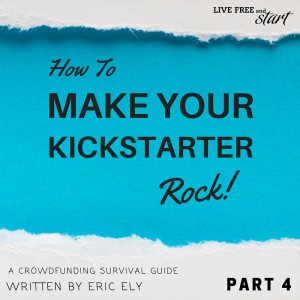
Originally posted on Live Fee and Start
You’re funded! Or not…
If not, don’t get too discouraged. Our first Kickstarter campaign failed to reach our goal. Instead of giving up, we went back to the drawing board and tried to find the problem. For us, it was a crappy video (see, our advice comes from experience!) and lack of a final design; we had a glove that didn’t even have our logo on it. We went out, re-did our campaign, and were successful on the second launch. I would say failing the first time was the single, biggest contributor to our success in subsequent campaigns.
Once you do get funded, you need to create whatever it is you promised. That is obviously specific to your project, so we won’t dive into too many details here. However, the one thing we will say, and this is critical, is that you need to be 100% transparent with your backers. They just gave you money for something that doesn’t exist; they bought in hard to your dream. You owe these people frequent (i.e. monthly) updates and pure honesty. Backers may get upset at delays or the limitations of your finished product, but they will be downright mutinous if you go silent on them. Being open and honest is a much easier path.
Before we sum up, here are a few more tips and tricks we learned along the way. The first is something we warmly refer to as “blood sucking leaches.” These are the people who reach out to campaigns like yours and make promises to “get your name to 10,000 journalists and media contacts” or “in front of 100,000 relevant Twitter followers.” In general, these people just want your money. They should be avoided at all costs. Yes, they may have a long list of journalist emails, but it probably won’t help you. Your time and money are much better spent finding relevant journalists to your project and sending them personal emails. Blasting the heck out of a big list won’t get you anywhere. If anything, you may get in trouble. We learned this when our MailChimp account suspended, and Kickstarter threatened to suspend us for unsolicited emails.
Unfortunately, press and journalists won’t help you as much as you’d like. The only thing they care about is getting readers to their publication, so they will do this however they see fit. That may or may not include your project. They also have deadlines and other articles they need to write, plus getting 1,000 email pitches every day. Nearly all of them will ignore you. All that said, you still need to plug away and try to get a few good stories. Even one can pay off big.
Once you are funded, you will also have a large following of people who want to share in your idea. These people are the best customers you will ever have; they gave you money before you had anything. You need to setup a system to nurture that community as fast as possible. As good as Kickstarter is in some things, this is not one of them. We recommend setting up a community forum or other relevant site so you can have discussions and gather feedback. There are a lot of great tools to do this. Discourse is a forums software that we use, for example. Whatever you use, be sure to have somewhere outside of Kickstarter where you can grow and interact with this community.
From a logistical standpoint, once you are funded, you won’t get the money for two weeks. You will also lose 8% of it (5% to Kickstarter plus 3% to Amazon Payments), and you will probably have another 1%-2% lost to declined credit card transactions. Plan for that.
Also, once you are funded, you may need to contact your backers to ask them questions. (What size t-shirt? What color? Etc.). Kickstarter has a terrible system for this. We highly recommend using a separate survey system; we used one called BackerKit. It seems expensive, but because it allows your backers to buy more stuff, it usually pays for itself. We got about 10% additional funds on one of our Kickstarter campaigns solely by using BackerKit.
In closing, we hope you find yourself on your way to creating your own projects and campaigns, and that this little series helps in some way. We are happy to share what we have learned so far. If we ever do another campaign, we may learn a whole new set of things that contradict what we already learned. Kickstarter is pretty fluid; each campaign has a life of its own, and it can be nearly impossible to predict. Just plan as best you can. Sometimes it sucks and sometimes it’s awesome, but it is a fantastic way to bring your dreams to fruition. It is a means to an end, but it is perhaps the most personal and available platform for many makers and inventors. We hope it brings you much success.